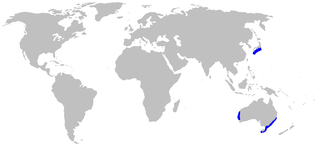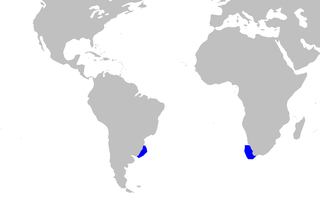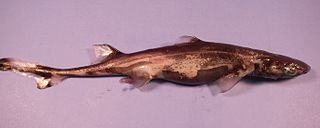
The Squaliformes are an order of sharks that includes about 126 species in seven families.

The goblin shark is a rare species of deep-sea shark. Sometimes called a "living fossil", it is the only extant representative of the family Mitsukurinidae, a lineage some 125 million years old. This pink-skinned animal has a distinctive profile with an elongated, flat snout, and highly protrusible jaws containing prominent nail-like teeth. It is usually between 3 and 4 m long when mature, though it can grow considerably larger such as one captured in 2000 that is thought to have measured 6 m (20 ft). Goblin sharks are benthopelagic creatures that inhabit upper continental slopes, submarine canyons, and seamounts throughout the world at depths greater than 100 m (330 ft), with adults found deeper than juveniles. Some researchers believe that these sharks could also dive to depths of up to 1,300 m (4,270 ft), for short periods of time.

The dusky smooth-hound, also called the smooth dogfish or the dog shark, is a species of houndshark in the family Triakidae. This shark is an olive grey or brown in color, and may have shades of yellow or grayish white. Females live to 16 years and males have a lifespan of 10 years. M. canis was the first shark recognised to have viral infections.

The cookiecutter shark, also called the cigar shark, is a species of small squaliform shark in the family Dalatiidae. This shark occurs in warm, oceanic waters worldwide, particularly near islands, and has been recorded as deep as 3.7 km (2.3 mi). It migrates vertically up to 3 km (1.9 mi) every day, approaching the surface at dusk and descending with the dawn. Reaching only 42–56 cm (16.5–22 in) in length, the cookiecutter shark has a long, cylindrical body with a short, blunt snout, large eyes, two tiny spineless dorsal fins, and a large caudal fin. It is dark brown, with light-emitting photophores covering its underside except for a dark "collar" around its throat and gill slits.

The bramble shark is one of the two species of sharks in the family Echinorhinidae. Aside from the eastern Pacific Ocean, it is found in tropical and temperate waters worldwide. This rarely encountered shark swims close to the bottom of the seafloor, typically at depths of 400–900 m (1,300–3,000 ft), though it may enter much shallower water. The bramble shark has a stout body with two small dorsal fins positioned far back and no anal fin. It can be readily identified by the large, thorn-like dermal denticles scattered over its body, some of which may be fused together. It is purplish brown or black in color and grows up to 3.1 m (10 ft) long.

The dumb gulper shark is a rare and endangered deepwater dogfish, known from only along the east coast of Australia and isolated spots north and west of New Zealand. It is also known as the dumb shark, Harrison's deep-sea dogfish, or Harrison's dogfish.

The black dogfish is a species of dogfish shark in the family Etmopteridae. It is common over the outer continental shelf and continental slope at depths of 180–2,250 m (590–7,380 ft). Females generally inhabit deeper water than males, and depending on the region, smaller sharks may occur at different depths than larger ones. This species is distributed widely in the Atlantic Ocean, from Greenland and Iceland to Virginia and West Africa in the north, and off southwestern Africa and Argentina in the south. The largest member of its family, the black dogfish, typically measures 60–75 cm (24–30 in) long. It has a stocky, dark brown body that is darker below than above, and bears scattered, minute bioluminescent organs. Its two dorsal fins are preceded by stout spines, and the anal fin is absent.

The bareskin dogfish is a little-known, deepwater dogfish shark of the family Etmopteridae. This species is found in the western Pacific from southern Japan to western and southeastern Australia as well as in New Zealand waters.

The kitefin shark or seal shark is a species of squaliform shark in the family Dalatiidae, and the only species in its genus. It is found sporadically around the world, usually close to the sea floor at depths of 200–600 m (660–1,970 ft). With a sizable oil-filled liver to maintain neutral buoyancy, this shark is able to cruise slowly through the water while expending little energy. The kitefin shark, the largest luminous vertebrate on record, has a slender body with a very short, blunt snout, large eyes, and thick lips. Its teeth are highly differentiated between the upper and lower jaws, with the upper teeth small and narrow and the lower teeth large, triangular, and serrated. Its typical length is 1.0–1.4 m (3.3–4.6 ft), though examples as long as 5.9 ft (180 cm) have been encountered.

The sixgill stingray is a species of stingray and the only extant member of the family Hexatrygonidae. Although several species of sixgill stingrays have been described historically, they may represent variations in a single, widespread species. This flabby, heavy-bodied fish, described only in 1980, is unique among rays in having six pairs of gill slits rather than five. Growing up to 1.7 m (5.6 ft) long, it has a rounded pectoral fin disc and a long, triangular, and flexible snout filled with a gelatinous substance. It is brownish above and white below, and lacks dermal denticles.

The Cuban dogfish is a dogfish, a member of the family Squalidae in the order Squaliformes.

The taillight shark is a little-known species of shark in the family Dalatiidae and the only member of its genus. It is known from only four specimens collected from deep oceanic waters in the southern Atlantic Ocean and Pacific Ocean. A small shark with a laterally compressed body and a bulbous snout, this species has unusual adaptations that indicate a specialized lifestyle: its pectoral fins are paddle-like and may be used for propulsion, unlike other sharks and it has a pouch-like gland on its abdomen that emits clouds of luminescent blue fluid. This shark is likely aplacental viviparous and a formidable predator for its size.

The whitefin dogfish is a species of deep-sea dogfish shark in the family Etmopteridae. It has only been found in the northwest Pacific Ocean off the southeastern coast of Japan, between the latitudes of 35 and 32°N. It inhabits continental slopes and seamounts at a depth of 320 to 1,100 m. Reproduction is ovoviviparous. It is of no interest to fisheries and almost nothing is known of its biology. The specific epithet ritteri is in honor of Dr. William Emerson Ritter of the University of California.

The smalleye pygmy shark is a little-known species of squaliform shark in the family Dalatiidae, found in water 150–2,000 m (490–6,560 ft) deep near Japan, the Philippines, and Australia. It migrates vertically daily, spending the day in deep water and the night in shallower water. One of the smallest shark species, the smalleye pygmy shark is known to reach only 22 cm (8.7 in) long. It has a blackish, spindle-shaped body with relatively small eyes, and a spine preceding the first dorsal fin, but not the second. Bioluminescent photophores occur on its underside, which may serve to disguise its silhouette from predators. This species feeds on small squid, krill, shrimp, and bony fishes. It is aplacental viviparous. The International Union for Conservation of Nature has assessed it as Least Concern, citing its wide distribution and lack of threat from fisheries.

The blurred lanternshark is a little-known species of dogfish shark in the family Etmopteridae, found around the world in benthic and pelagic habitats from a depth of 110 m (360 ft) to over 1 km (0.62 mi) down. This shark forms the E. pusillus species group with the smooth lanternshark, which are distinguished from other members of its family by having irregularly arranged, flat-topped dermal denticles that give them a "smooth" appearance. Both species are slender-bodied with long heads, two dorsal fins bearing spines, no anal fins, and light-emitting photophores. The blurred lanternshark is larger, reaching 67 cm (26 in) or more in length. This species feeds on small squid, fishes, and fish eggs, and is ovoviviparous. It has been assessed as of Least Concern by the International Union for Conservation of Nature, because of its wide distribution and lack of threat from fishing pressure.

The smooth lanternshark or slender lanternshark is a species of dogfish shark in the family Etmopteridae, found widely in the Atlantic and Pacific Oceans. It inhabits benthic environments at a depth of 274–1,000 m (899–3,281 ft), and pelagic environments at a depth of 0–708 m (0–2,323 ft). The smooth lanternshark forms a species group with the larger blurred lanternshark, both of which are distinguished from other members of their family by small, irregularly arranged dermal denticles with a truncated shape. This species has a slender, dark brown body with an indistinct black band on the sides over the pelvic fins, and reaches 50 cm (20 in) in length. This slow-growing, ovoviviparous shark feeds on smaller squid, fishes, and fish eggs. Smooth lanternsharks are often caught as bycatch in eastern Atlantic and Japanese commercial fisheries. The International Union for Conservation of Nature (IUCN) has evaluated this species as of Least Concern because of its wide distribution and limited threats.

The velvet belly lanternshark is a species of dogfish shark in the family Etmopteridae. One of the most common deepwater sharks in the northeastern Atlantic Ocean, the velvet belly is found from Iceland and Norway to Gabon and South Africa at a depth of 20–2,490 m (66–8,169 ft). A small shark generally no more than 45 cm (18 in) long, the velvet belly is so named because its black underside is abruptly distinct from the brown coloration on the rest of its body. The body of this species is fairly stout, with a moderately long snout and tail, and very small gill slits. Like other lanternsharks, the velvet belly is bioluminescent, with light-emitting photophores forming a species-specific pattern over its flanks and abdomen. The ventral photophores are thought to function in counter-illumination, which camouflages the shark against predators and prey. The bioluminescent flank markings may play a role in intraspecific communication.

The green lanternshark is a species of dogfish shark in the family Etmopteridae, found in the western central Atlantic Ocean. This species usually occurs on the upper continental slope below a depth of 350 m (1,150 ft). Reaching 26 cm (10 in) in length, the green lanternshark has a slender body with a long, thin tail and low, conical dermal denticles on its flanks. It is dark brown or gray with ventral black coloration, which contain light-emitting photophores that may serve a cryptic and/or social function. Green lanternsharks are thought to be gregarious and may attack their prey, squid and octopus often larger than themselves, in packs. Reproduction is aplacental viviparous, with females giving birth to litters of one to three young. This relatively common shark is an occasional, valueless bycatch of commercial fisheries; currently it does not appear to be significantly threatened by human activities.

The dwarf lanternshark is a little-known species of dogfish shark in the family Etmopteridae and is the smallest shark in the world, reaching a maximum known length of 20 cm (7.9 in). It is known to be present only on the upper continental slopes off Colombia and Venezuela, at a depth of 283–439 m (928–1,440 ft). This species can be identified by its small size at maturity, long flattened head, and pattern of black ventral markings and a mid-dorsal line. Like other members of its genus, it is capable of producing light from a distinctive array of photophores. Reproduction is aplacental viviparous, with females gestating two or three young at a time. The dwarf lanternshark is not significant to commercial fisheries, but could be threatened by mortality from bycatch; the degree of impact from human activities on its population is unknown.

The brown lanternshark or bristled lanternshark is a little-known species of deep-sea dogfish shark in the family Etmopteridae. It is found off Japan and New Zealand, and possibly also South Africa and Australia, typically deeper than 300 m (980 ft). This species can be distinguished from other lanternsharks by its coloration, which is a uniform dark gray or brown without the ventral surface being much darker and clearly delineated from the rest of the body. The brown lanternshark feeds on small bony fishes, cephalopods, and crustaceans. Reproduction is ovoviviparous, with females giving birth to 9–18 young. An unusually high proportion of individuals in Suruga Bay are hermaphrodites, with both male and female characteristics.
























